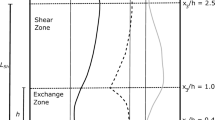Abstract
Connections between the spatial and temporal statistics of turbulent flow, and their possible convergence to ensemble statistics as assumed by the ergodic hypothesis, are explored for passive scalars within a rod canopy. While complete ergodicity is not expected to apply over all the spatial domain within such heterogeneous flows, the fact that canopy turbulence exhibits self-similar characteristics at a given depth within the canopy encourages a discussion on necessary conditions for an ‘operational’ ergodicity framework. Flows between roughness elements such as within canopies exhibit features that distinguish them from their well-studied classical boundary-layer counterparts. These differences are commonly attributed to short-circuiting of the energy cascade and the prevalence of intermittent von Kármán vortex streets in the deeper layers of the canopy. Using laser-induced fluorescence measurements at two different depths within a rod canopy situated in a large flume, the spatio-temporal statistical properties and concomitant necessary conditions for ergodicity of passive scalar turbulence statistics are evaluated. First, the integral time and length scales are analyzed and their corresponding maximum values are used to guide the construction of an ensemble of independent realizations from repeated spatio-temporal concentration measurements. As a statistical analysis for an operational ergodicity check, a Kolmogorov–Smirnov test on the distributions of temporal and spatial concentration series against the ensemble was conducted. The outcome of this test reveals that ergodicity is reasonably valid over the entire domain except close to the rod elements where wake-induced inhomogeneities and damped turbulence prevail. The spatial concentration statistics within a grid-cell (square domain formed by four corner rods) appear to be less ergodic than their temporal counterparts, which is not surprising given the periodicity and persistence of von Kármán vortices in the flow field. Also, a local advection velocity of dominant eddies is inferred using lagged cross-correlations of scalar concentration time series at different spatial locations. The computed probability density function of this advection velocity agrees well with the laser Doppler anemometry measurements for the same rod canopy.









Similar content being viewed by others
References
Baldocchi D, Meyers T (1998) On using eco-physiological, micrometeorological and biogeochemical theory to evaluate carbon dioxide, water vapor and trace gas fluxes over vegetation: a perspective. Agric For Meteorol 90(1):1–25
Chen J, Hu Y, Yu Y, Lü S (2014) Ergodicity test of the eddy correlation method. Atmos Chem Phys Discuss 14:18207–18254
Constantin P, Glatt-Holtz N, Vicol V (2013) Unique ergodicity for fractionally dissipated, stochastically forced 2D Euler equations. Commun Math Phys 46:1–39
DaPrato G, Debussche A (2003) Ergodicity for the 3D stochastic Navier–Stokes equations. J Math Pures Appl 82:877947
Finnigan J (2000) Turbulence in plant canopies. Annu Rev Fluid Mech 32(1):519–571
Galanti B, Tsinober A (2004) Is turbulence ergodic? Phys Lett A 330:173180
Higgins C, Froidevaux M, Simeonov V, Vercauteren N, Barry C, Parlange M (2012) The effect of scale on the applicability of Taylors frozen turbulence hypothesis in the atmospheric boundary layer. Boundary-Layer meteorol 143:379–391
Higgins C, Katul G, Froidevaux M, Simeonov V, Parlange MB (2013) Are atmospheric surface layer flows ergodic? Geophys Res Lett 40:33423346
Katul G, Albertson J (1998) An investigation of higher-order closure models for a forested canopy. Boundary-Layer Meteorol 89(1):47–74
Katul G, Lai CT, Schäfer K, Vidakovic B, Albertson J, Ellsworth D, Oren R (2001) Multiscale analysis of vegetation surface fluxes: from seconds to years. Adv Water Resour 24(9):1119–1132
Katul GG, Mahrt L, Poggi D, Sanz C (2004) One-and two-equation models for canopy turbulence. Boundary-Layer Meteorol 113(1):81–109
Landau LD, Lifshitz EM (1980) Course of theoretical physics. Elsevier, Amsterdam, 537 pp
Lesieur M (1990) Turbulence in fluids. Kluwer, Dordrecht, 367 pp
Mattingly J, Weinan E (2001) Ergodicity for the Navier–Stokes equation with degenerate random forcing: finite-dimensional approximation. Commun Pure Appl Math 54:13861402
Monin A, Yaglom A (1971) Statistical fluid mechanics: mechanics of turbulence, vol 1. MIT Press, Cambridge, 695 pp
Nathan R, Katul GG, Horn HS, Thomas SM, Oren R, Avissar R, Pacala SW, Levin SA (2002) Mechanisms of long-distance dispersal of seeds by wind. Nat Lett 418(6896):409–413
Poggi D, Katul G (2006) Two-dimensional scalar spectra in the deeper layers of a dense and uniform model canopy. Boundary-Layer Meteorol 121:267–281
Poggi D, Porporato A, Ridolfi L (2002) An experimental contribution to near-wall measurements by means of a special laser Doppler anemometry technique. Exp Fluids 32(3):366–375
Poggi D, Katul G, Albertson J (2004a) Momentum transfer and turbulent kinetic energy budgets within a dense model canopy. Boundary-Layer Meteorol 111:589–614
Poggi D, Porporato A, Ridolfi L, Albertson J, Katul G (2004b) The effect of vegetation density on canopy sub-layer turbulence. Boundary-Layer Meteorol 111(3):565–587
Poggi D, Katul G, Albertson J (2006) Scalar dispersion within a model canopy: measurements and three-dimensional Lagrangian models. Adv Water Resour 29(2):326–335
Poggi D, Katul G, Cassiani M (2008) On the anomalous behavior of the Lagrangian structure function similarity constant inside dense canopies. Atmos Environ 42:4212–4231
Poggi D, Katul G, Vidakovic B (2011) The role of wake production on the scaling laws of scalar concentration fluctuation spectra inside dense canopies. Boundary-Layer Meteorol 139(1):83–95
Stanisic M (1985) Mathematical theory of turbulence. Springer, New York, 482 pp
Sutton M, Schjorring J, Wyers G, Duyzer J, Ineson P, Powlson D (1995) Plant–atmosphere exchange of ammonia [and discussion]. Philos Trans R Soc 351(1696):261–278
Taylor G (1938) The spectrum of turbulence. Proc R Soc Lond Ser A 164:476–479
Acknowledgments
Support from the National Science Foundation (NSF-AGS-1102227 and NSF-EAR-1344703), the United States Department of Agriculture (2011-67003-30222), and the U.S Department of Energy (DOE) through the Office of Biological and Environmental Research (BER) Terrestrial Carbon Processes (TCP) program (DE-SC0006967 and DE-SC0011461) is acknowledged.
Author information
Authors and Affiliations
Corresponding author
Rights and permissions
About this article
Cite this article
Ghannam, K., Poggi, D., Porporato, A. et al. The Spatio-temporal Statistical Structure and Ergodic Behaviour of Scalar Turbulence Within a Rod Canopy. Boundary-Layer Meteorol 157, 447–460 (2015). https://doi.org/10.1007/s10546-015-0073-1
Received:
Accepted:
Published:
Issue Date:
DOI: https://doi.org/10.1007/s10546-015-0073-1




